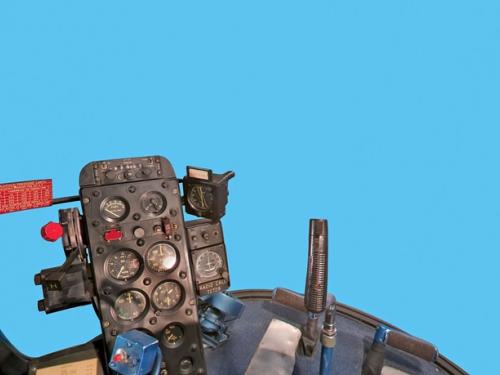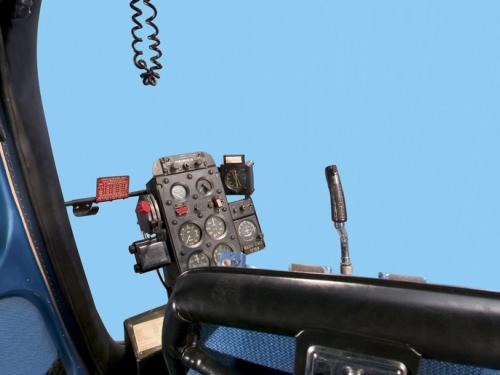On July 12, 1957, Dwight D. Eisenhower became the first President of the United States to fly in this helicopter. The occasion was a simulated nuclear alert staged to test how quickly the Chief Executive and other government officials could depart Washington, D. C. and reach a safe haven outside the city. During 1957, the Bell Helicopter Corporation modified a stock Bell H-13J helicopter to meet the President's special needs. Technicians added all-metal rotor blades, special arm and foot rests to the right seat, and a frame-less, Plexiglas nose bubble heavily tinted to reduce glare and heat. Eisenhower's personal helicopter pilot, United States Air Force Major Joseph E. Barrett, flew the rotorcraft from the center seat and a Secret Service agent occupied the left seat.
An identical Bell H-13J, assigned the Air Force serial number 57-2728, usually accompanied the President's helicopter. This aircraft carried his physician and another Secret Service agent.
Bell H-13J
Lawrence Bell invested in helicopter research during World War Two to develop a commercial product that he could market after the war ended. When Igor Sikorsky won several wartime contracts to build military helicopters, Bell began to believe that one day the helicopter might become a common mode of personal transportation. Yet much work remained before he and the company could even hope to compete successfully in this potential new market. The biggest problem facing Bell and his design staff was that no one understood the aerodynamic and engineering principles of rotary winged flight.
In 1941, an enthusiastic, free-lance engineer named Arthur Young asked Bell to watch a demonstration of a remote control, flying model helicopter that Young had devoted the last decade to developing. Bell watched the model fly with remarkable stability and control. The key to this advanced performance lay in a stabilizer bar, attached to the main rotor hub, that Young had invented and patented. Bell recognized the inventor's talent immediately. He hired Young, put him to work alongside Bell's friend and engineering assistant, Bartram Kelly, and instructed the men to build a full-scale, flying prototype of Young's helicopter design. Bell named it the Model 30 (see NASM collection) and it first flew on December 18, 1942.
By 1945, the Model 30 demonstrator could fly and carry enough payload capacity to encourage Bell to proceed with a larger, commercial version called the Model 42. Backed by the Model 30's success and flashy styling, the Model 42 seemed destined to win production orders but it failed completely after company politics choked the design process. The senior staff at Bell resented Arthur Young's lack of formal training and ignored his inputs. This led to poor engineering decisions and shoddy quality control during production. Larry Bell also misread the market for the Model 42 and aimed the aircraft at private pilots and their families. In reality, it was commercial operators who needed the unique capabilities offered by the helicopter.
Bell decided to step back and rethink his approach. He chose to refine the Model 30 design, install a more powerful engine and side-by-side seating for two, and one of the most successful helicopter designs of the twentieth century resulted. It was the first helicopter designed exclusively for the civil market rather than military customers. Bell called it the Model 47 for the year he introduced it and he sold two versions. The stylish coupe model was again aimed at private owners and again, it did not sell. The utility model hit the commercial market squarely between the eyes. It was lean and utilitarian, stripped of styling gimmicks, and ready for work. Bell enclosed the cockpit beneath a huge, unframed bubble canopy and this distinctive feature is now recognized worldwide.
The utility version sold slowly at first but by 1949, customers were buying enough Model 47s to convince Bell to develop the design further. The Air Force, which oversaw the procurement of aircraft for the Army under a Congressional directive, purchased the Bell 47 for the service under the H-13 designation. Army and Marine pilots, flying Model 47s, evacuated over 15,000 wounded personnel during the Korean War with an unprecedented death rate of less than 2 percent. Bell continued to refine the Model 47 design, based on the needs of military and commercial customers. The firm installed more powerful engines and larger fuel tanks to increase range and endurance, and lift larger payloads. Military operations in Korea and sales to the commercial oil industry kept Bell production lines moving at a brisk pace. By the first half of 1953, the company had delivered more than 1,000 Model 47s.
In 1954, Bell started building the Model 47H, a version that weighed less than pervious models because a new stressed-skin, semi-monocoque tail boom replaced the old welded steel-tube boom. A pilot could fly the 47H about 20 percent faster than older models. The new version also carried an additional seat and a relatively spacious baggage compartment. In 1955, Bell followed up the 47H with the 47J Ranger, a version designed to appeal to the business community. The "Ranger" could accommodate three passengers seated on a bench behind a single pilot.
As the Cold War arms race intensified during the 1950s, the Soviet Union steadily upgraded its strategic bomber and submarine forces. United States strategists began to fear that the Soviets might launch a successful first strike using nuclear weapons. The U. S. government constructed underground command centers to protect the national leadership and allow it to maintain its authority in the event of a nuclear strike. These bunkers were located in rural areas and U. S. strategic planners conducted several exercises to test how quickly national leaders could travel from downtown Washington to command posts outside the city. During one civil defense drill, President Dwight D. Eisenhower rode in his personal limousine while cabinet members flew in a helicopter and arrived at the bunker far sooner than the president. This sobering outcome sparked the search for a suitable helicopter to whisk the Chief Executive to safety.
President Dwight D. Eisenhower's chief pilot, Air Force Col. William G. Draper, had spent most of the President's term searching for small aircraft, including helicopters, capable of carrying the chief executive comfortably and safely to the small airport near his Gettysburg, Pennsylvania farm. However, until 1955, the Secret Service had refused to allow the President to fly in any aircraft equipped with less than four engines. While a helicopter seemed like an obvious solution, an U-4B Aero Commander served as the President's light transport until Draper could find a model that met the Secret Services stringent standards. He rejected the large Sikorsky helicopters because of the noise they produced and he also had misgivings about their safety record. He also found that earlier Model 47s, while reliable, could not carry the pilot, the President and a Secret Service agent comfortably.
Early in 1957, Draper decided that the Bell H-13J Ranger was the ideal presidential helicopter and the United States Air Force purchased two to fill this critical need. These new aircraft were nearly identical to the standard production Ranger configured as a commercial executive transport. Bell only added two new features to the presidential H-13Js; all-metal rotor blades to increase the helicopter's useful load, and special anti-glare tinting to the huge plexiglass nose bubble.
U. S. Air Force spokesmen played down the national defense role of the new presidential helicopters when "The New York Times" announced the purchase of the President's new helicopters on February 20, 1957. The helicopters would shorten Eisenhower's trips to the Military Air Transport terminal at National airport, across the Potomac River from the White House. Once the Chief Executive arrived, he would then board one of his personal aircraft, a Lockheed Super Constellation named "Columbine III," or one of his two Aero Commander 560s, used for shorter trips.
Col. Draper also chose Eisenhower's personal helicopter pilot, Maj. Joseph E. Barrett. He selected Barrett because of his extensive record as a combat pilot. Maj. Barrett flew Boeing B-17 Flying Fortresses (see NASM collection) in World War II, and he was awarded the Silver Star during the Korean War for a helicopter rescue flight he undertook 70 miles behind enemy lines.
A minor uproar was created when a Pennsylvania newspaper stated that Eisenhower, an avid golfer, "will become so fond of this means of transportation he'll begin using the Rangers for trips to … Burning Tree Country Club." The Air Force quickly countered by admitting that the President would fly in the helicopter during a major civil defense exercise called "Operation Alert." This admission quieted criticism of the helicopters as an extravagant and useless perk.
"Operation Alert" began on July 12, 1957, and by mid-afternoon, Eisenhower had become the first U.S. President to fly on board a helicopter. Maj. Barrett flew the H-13J bearing serial number 57-2729. He carried President Eisenhower and a Secret Service agent. The President sat in the right rear seat but leaned against a special armrest installed for him on the center seat. Eisenhower also used a special footrest. The second Ranger, serial number 57-2728, carried the President's personal physician and another Secret Service agent. Both helicopters were based in a hangar at National Airport, along with the other presidential aircraft.
In September 1957, Eisenhower made an unscheduled return from Newport, Rhode Island. He flew aboard a Marine Sikorsky UH-34D Seahorse helicopter (see NASM collection) for part of this journey. The passenger cabin inside the Seahorse was more than three times the size of the Bell Ranger and the President immediately recognized the advantages of flying in this much larger helicopter. The Bell could not carry aides or family members and seemed cramped even during short flights. Because the Air Force did not operate large helicopters as part of its mission, the United States Army and the Marine Corps formed detachments to provide the much more spacious UH-34 helicopters for presidential transport and the H-13Js were used for transporting other high level VIPs. Eisenhower tried to avoid favoring either service by alternating his trips between the Army and Marine helicopters. For a time, both services maintained presidential helicopter units but eventually only the Marine Corps possessed suitable aircraft, and to this day, the official Presidential helicopter is designated "Marine One."
The Air Force presidential helicopter mission ended with the Eisenhower presidency. In 1961, the Air Force relocated the H-13Js to Bolling Air Force Base across the Anacostia River from Washington, and assigned them to the 1001st Helicopter Squadron. This unit provided VIP transport to cabinet members, defense department officials, and occasionally the Vice President. In 1962, the Air Force added a "U" to the H-13J's prefix to denote its utility function. The Air Force retired both of the former Presidential transport UH-13J's in 1967 and transferred the helicopters to museums the following year. The Smithsonian Institution received 57-2729, which was the first to carry Eisenhower, and the United States Air Force Museum in Dayton, Ohio, accepted the other aircraft, serial number 57-2728.
Rotor Diameter: 11.3 m (37 ft 2 in)
Length: 9.9 m (32 ft 5 in)
Height: 2.8 m (9 ft 4 in)
Weights: Empty, 862 kg (1,900 lb)
Gross, 1,293 kg (2,850 lb)
Engine: Lycoming VO-435 A1E, 240 horsepower
References and Further Reading:
Spencer, Jay P. "Whirlybirds: A History of the U.S. Helicopter Pioneers." Seattle:
University of Washington Press, 1998.
Bell UH-13J curatorial file, Aeronautics Division, National Air and Space Museum.
This object is not on display at the National Air and Space Museum. It is either on loan or in storage.
Length: 9.9 m (32 ft 5 in)
Height: 2.8 m (9 ft 4 in)
Weights: Empty, 862 kg (1,900 lb)
Gross, 1,293 kg (2,850 lb)
For more information, visit the Smithsonians Terms of Use.

